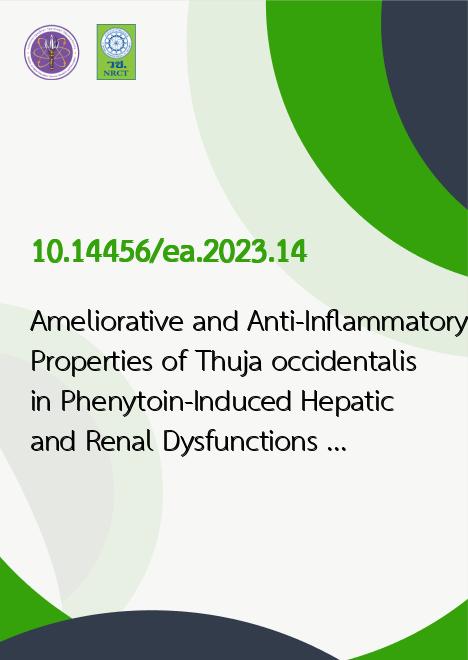
|
Ameliorative and Anti-Inflammatory Properties of Thuja occidentalis in Phenytoin-Induced Hepatic and Renal Dysfunctions in Male Albino Rats |
|---|---|
| รหัสดีโอไอ | |
| Creator | Abdel-Aziz A. A. El-Sayed |
| Title | Ameliorative and Anti-Inflammatory Properties of Thuja occidentalis in Phenytoin-Induced Hepatic and Renal Dysfunctions in Male Albino Rats |
| Publisher | Thai Society of Higher Education Institutes on Environment |
| Publication Year | 2566 |
| Journal Title | EnvironmentAsia |
| Journal Vol. | 16 |
| Journal No. | 1 |
| Page no. | 157-168 |
| Keyword | Phenytoin, Thuja occidentalis, Hepatotoxicity, Nephrotoxicity, Cytokines |
| URL Website | http://www.tshe.org/ea/index.html |
| Website title | EnvironmentAsia |
| ISSN | 1906-1721 |
| Abstract | Phenytoin (PHT) is one of the most used anticonvulsants in the developing world, but lackof monitoring and concurrent medications can easily cause harmful negative effects on theliver and kidneys. Herbal medicines have consistently drawn the interest of researchersin contrast to drug therapies, which have a number of negative effects. The current studylooked into the protecting impacts of Thuja occidentalis (TO) against phenytoin-exposedrats' hepatic and renal damage. In the current work, young, non-woody Thuja occidentalis L.was extracted using a newly made methanolic solution. This study used distillation-basedmethods to obtain branches with leaves. The study involved of three groups of eight rats pergroup. Group I rats acted as a control group, whereas group II take 75 mg/kg of PHT alone.Groups III received PHT parallel to TO 200 mg/kg for 14 consecutive days. Liver and kidneytissues prepared for histological examination and serum samples separated for biomarkers.(I) liver injury indicator enzymes, alanine aminotransferase ALT, aspartate aminotransferaseAST and alkaline phosphatase ALP; (II) kidney injury indicators as urea and creatinine. (III)inflammatory markers, interleukins (IL-1?, IL-1?, IL-4, IL-6, IL-10, IFN-? and IFN-?) weresubsequently determined. The findings showed that PHT exposure group elicited significantincreases (p < 0.05) in ALT, AST, ALP, urea and creatinine levels. Moreover, some hepaticand renal histological changes were observed. However, rats co-treated with TO, had theirfunctional indices of the liver and kidneys returned to nearly normal levels. In conclusion,Thuja occidentalis might guard the liver and kidneys from damage brought on by PHT medication. |